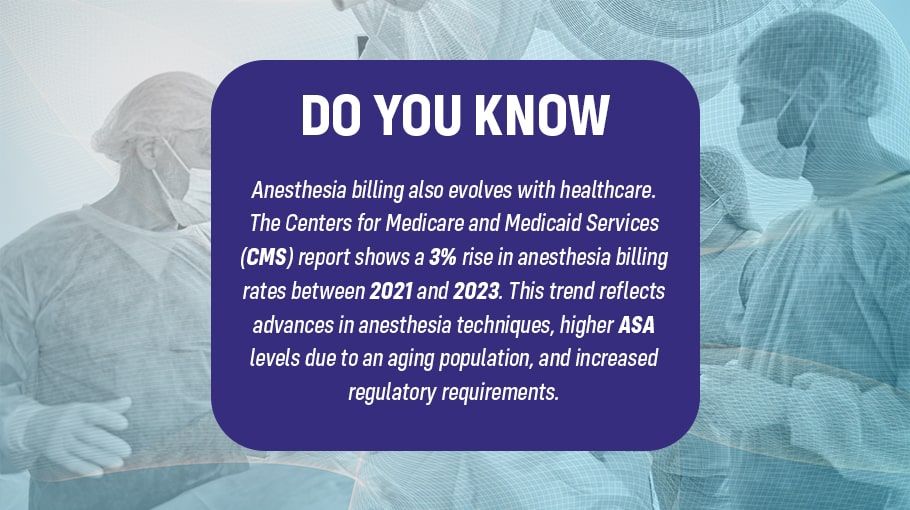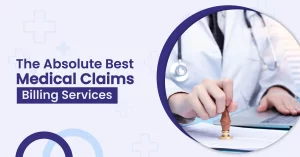Hospital billing for anesthesia services can be stressful and complex. Due to the various complexities, a thorough understanding of this process is essential for healthcare providers. We’ll simplify the process of how hospitals bill for anesthesia services in this guide. Also, we will discuss the importance of anesthesia medical billing, formula, and how an expert Anesthesia Billing Services provider can help you. Let’s see hospitals fulfill this responsibility.
Significance of Anesthesia Billing for Hospitals
Accurate billing is vital for hospitals and providers. Furthermore, the changing nature of the healthcare industry, as evidenced by improvements in anesthetic procedures and shifting patient health profiles, only highlights the importance of proper billing. For example, an increase in anesthesia billing rates between 2021 and 2023 indicated the need for more complex ASA levels due to an aging population and regulatory standards.

Anesthesia billing also evolves with healthcare. The Centers for Medicare and Medicaid Services (CMS) report shows a 3% rise in anesthesia billing rates between 2021 and 2023. This trend reflects advances in anesthesia techniques, higher ASA levels due to an aging population, and increased regulatory requirements.
In short, accurate anesthesia billing is essential to a hospital’s financial stability and critical in determining its ability to generate revenue and adhere to regulatory guidelines. As a result, it is an area that demands serious consideration and persistent efforts to develop.
ASA Classification System for Anesthesia Billing
The American Society of Anesthesiologists (ASA) Physical Status Classification System is vital in anesthesia billing. It classifies patients according to their health. This ranking then affects how complex it is to give anesthesia to the patient and how risky it might be. This, in turn, impacts the cost of anesthesia services.
ASA Classification System for Anesthesia Billing
| Classification | Description | Example |
| ASA I | A normal, healthy patient. | Fit, nonobese (BMI under 30), a nonsmoking patient with good exercise tolerance. |
| ASA II | A patient with mild systemic disease. | Patient with no functional limitations and a well-controlled disease (e.g., treated hypertension, obesity with BMI under 35, frequent social drinker, or cigarette smoker). |
| ASA III | A patient with a severe systemic disease that is not life-threatening. | Patient with some functional limitation due to disease (e.g., poorly treated hypertension or diabetes, morbid obesity, chronic renal failure, a bronchospastic disease with intermittent exacerbation, stable angina, implanted pacemaker). |
| ASA IV | A patient with a severe systemic disease is a constant threat to life. | Patient with functional limitation from severe, life-threatening disease (e.g., unstable angina, poorly controlled COPD, symptomatic CHF, recent (less than three months ago) myocardial infarction or stroke). |
| ASA V | A moribund patient who is not expected to survive without the operation. | The patient is not expected to survive beyond the next 24 hours without surgery—examples: ruptured abdominal aortic aneurysm, massive trauma, and extensive intracranial hemorrhage with mass effect. |
| ASA VI | A brain-dead patient whose organs are being removed to transplant them into another patient. | (No specific example, as the definition is self-explanatory) |
| ASA (with “E”) | Denotes an emergency surgical procedure. | The ASA defines an emergency as “when the delay in treatment of the patient would lead to a significant increase in the threat to life or body part.” |
ASA I
This classification is reserved for regular, healthy patients with no underlying medical conditions. An example could be a young individual undergoing a minor elective procedure. The anesthesia billing rate for ASA I patients is typically the lowest due to the minimal risk associated with administering anesthesia.
ASA II
ASA II classifies patients with mild systemic diseases that are well-controlled and do not limit their daily activities. An example could be a patient with well-managed hypertension or controlled diabetes. Due to increased risks, anesthesia billing rates for ASA II patients are higher than for ASA I.
ASA III
Patients under ASA III have severe systemic diseases that limit their activity but are not disabled. Examples might include a patient with angina, a history of heart attack, or poorly controlled hypertension. The anesthesia billing rate for ASA III patients is higher, reflecting the elevated risk of complications during anesthesia.
ASA IV
ASA IV patients have life-threatening systemic diseases. Examples may include patients with ongoing cardiac ischemia and severe kidney or liver disease. Given the life-threatening nature of these conditions and the higher risk of anesthesia complications, the anesthesia billing rate for ASA IV patients is significantly higher.
ASA V
Patients classified under ASA V are critically ill and not expected to survive without the surgery. These might be patients with ruptured abdominal aneurysms or severe trauma. These patients present the highest anesthesia risks, so the billing rate is commensurately high.
ASA VI
ASA VI includes brain-dead patients who are being kept alive for organ donation. The billing rate reflects the complexity and resource utilization in these situations.
Anesthesia Billing Process for Hospitals
It can be challenging to process hospital bills, especially for specialty procedures like anesthesia.
Understanding how this system operates is essential for all healthcare professionals because several factors
affect the ultimate invoice. Let’s see how hospitals bill for anesthetic services.
Anesthesia Billing Units
Anesthesia billing is unique compared to other medical services. The calculation includes base units (reflecting the complexity of the procedure), time units (actual Time administering anesthesia), and modifying units (patient health status, age, or other complexities).
Base Units
Base units are used to confirm the anesthesia rates for a particular operation code. It allows the user to compare the payment amount on a bill line item to the basic unit data. This feature is crucial since it enables the user to verify whether the provider actually received the correct payment for the anesthetic service they rendered.
Time Units
As a time unit is whatever the contract specifies, the valuation, in this case, varies by contract. There are contracts with five units per hour and others with four. Medicare pays a portion for each minute, with some contracts specifying that the next team will take the field in the first minute of the period and others in the fifth. Time passes while the doctor takes over the patient’s care and continues to provide ongoing care for the patient until the patient is turned over and the report is finished.
Modifier Units
This group of units covers various sections, including emergencies, patient ages, physical conditions, CRNA supervision, controlled hypotension, hypothermia, unusual positions, field avoidance, and much more. In this essay, I won’t go into detail about this void. Additionally, the insurer does not always cover these.
Anesthesia Billing Formula Used By Hospitals
The formula looks something like this: (Base Units + Time Units + Modifying Units) x Conversion Factor = Anesthesia Fee
The “conversion factor” varies by geographic location and is adjusted annually.
Core Components of Anesthesia Services
Anesthesia services comprise three essential parts:
Pre-anesthesia evaluation
This involves a thorough assessment of the patient’s medical condition before administering anesthesia.
Anesthesia time
It refers to the duration of anesthesia administered to the patient.
Post-anesthesia care
The period of patient monitoring after the operation until the patient has recovered sufficiently.
These three components collectively form the “anesthesia package” for which hospitals bill.
BellMedEx: Comprehensive Suite for Anesthesia Billing Services
Outsourcing an anesthetic billing services provider is essential to maximize the eligible income from your anesthetic services. Whether this is done internally or externally, it will ensure you get the most out of your claims and lower administrative costs. The professionals will be your best source for answers to questions concerning anesthetic billing.
At Bell MedEx, we handle the many complications and faults in the anesthetic billing process to make it more manageable for our clients. Our knowledge helps you maximize the profit from your anesthetic services while saving you time and money.
Get Your Pre-Anesthesia Evaluation Report Complete With:
The Anesthesia Record
Anesthesia record is a detailed document that includes all the information related to the anesthesia administration, such as the type and dose of anesthesia used, the duration of anesthesia, and any complications or interventions during the procedure. Medifusion EHR software ensures that all these details are correctly documented for accurate billing.
The ABN Form for Anesthesia
The Advanced Beneficiary Notice (ABN) is a form that Medicare beneficiaries must sign if they receive services that may not be covered by Medicare. BellMedEx ensures compliance with HIPAA regulations by including the ABN form in the pre-anesthesia evaluation report.
Why Choose BellMedEx for Anesthesia Billing Services?
Comprehensive Suite
We are not just a billing service. We offer a complete solution to your anesthesia billing needs.
Maximized Revenue
With expertise in anesthetic billing, we ensure you don’t leave money on the table. Reap the benefits of eligible income from your services.
Reduced Administrative Costs
Save money by minimizing errors and cutting down unnecessary overhead.
Expert Guidance
Have questions? Our team has the answers when it comes to anesthetic billing nuances.
Simplify Your Anesthesia Billing Process With Bell MedEx
If you face complicated billing issues. BellMedEx helps you in fixing and streamlining the billing process. As a result you enjoy increased revenue, saved time, and peace of mind.
Contact BellMedEx today and elevate your practice’s potential.





